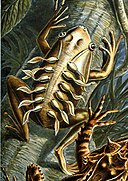Ficheiro:Haeckel Batrachia.jpg

Dimensões desta antevisão: 424 × 599 píxeis. Outras resoluções: 170 × 240 píxeis | 339 × 480 píxeis | 543 × 768 píxeis | 724 × 1 024 píxeis | 2 323 × 3 284 píxeis.
Imagem numa resolução maior (2 323 × 3 284 píxeis, tamanho: 2,17 MB, tipo MIME: image/jpeg)
Histórico do ficheiro
Clique uma data e hora para ver o ficheiro tal como ele se encontrava nessa altura.
| Data e hora | Miniatura | Dimensões | Utilizador | Comentário | |
|---|---|---|---|---|---|
| atual | 03h17min de 24 de fevereiro de 2006 |  | 2 323 × 3 284 (2,17 MB) | Ragesoss | improve version, based on same original scan |
| 00h22min de 11 de fevereiro de 2006 |  | 2 318 × 3 280 (2,21 MB) | Ragesoss | The 68th plate from Ernst Haeckel's 1899 ''Kunstformen der Natur'', depicting frogs classified as Batrachia. Category:Ernst Haeckel |
Utilização local do ficheiro
A seguinte página usa este ficheiro:
Utilização global do ficheiro
As seguintes wikis usam este ficheiro:
- arz.wikipedia.org
- ast.wikipedia.org
- az.wikipedia.org
- ban.wikipedia.org
- be.wikipedia.org
- bg.wikipedia.org
- ca.wikipedia.org
- ca.wikibooks.org
- ceb.wikipedia.org
- ckb.wikipedia.org
- dag.wikipedia.org
- de.wikipedia.org
- din.wikipedia.org
- el.wikipedia.org
- en.wikipedia.org
- Wikipedia:Featured pictures thumbs/04
- Wikipedia:Picture of the day/June 2006
- User:Ragesoss/Haeckel
- Wikipedia:Featured picture candidates/Haeckel Batrachia.jpg
- Wikipedia:Wikipedia Signpost/2006-03-13/Features and admins
- Wikipedia:Featured picture candidates/March-2006
- Talk:Frog/Archive 3
- User talk:Ragesoss/Archive1
- Wikipedia:Picture of the day/June 12, 2006
- Wikipedia:POTD/June 12, 2006
- Wikipedia:POTD column/June 12, 2006
- Wikipedia:POTD row/June 12, 2006
- Kunstformen der Natur
- User:Samsara/Frog/Stable
- User:RichardF/POTD
- Wikipedia:WikiProject Germany/Gallery
- User:Froggyyes~enwiki
- Wikipedia:Featured pictures/Animals/Amphibians
- Unclean spirit
- User:Xophist/s5
- Wikipedia:Wikipedia Signpost/2006-03-13/SPV
- Talk:Alfred Russel Wallace/Archive 1
- Portal:Amphibians/Selected picture
- User:The Transhumanist/Sandbox144
- Template:POTD/2006-06-12
Ver mais utilizações globais deste ficheiro.







